Landkreis Berchtesgadner Land - the extreme South Eastern county in Germany. It is a very beautiful alpine county, within sight of the Austrian city of Salzburg. The highest lake in Germany, the Königsee is nestled in one of the steep valleys neighboring the town of Berchtesgaden. Like the nearby Bad Reichenhall and Salzburg, Salt has been mined here since 1517. The village of Berchtesgaden itself is at the eastern end of the Deutsche Alpenstrasse - the German Alpine Road - stretching all the way to the Bodensee (the largest lake in Europe, at the border of Switzerland, Austria, and Germany). The whole area is still rather rural today.
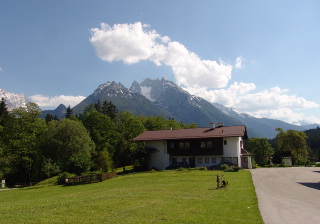
Berchtesgaden is primarily on the northern bank of the stream that drains the Königsee, nestling into the southern slope of the northernmost ridgeline of the Alps. To the south, the town is dominated (visually) by the split moutain peak of the Watzmann (8,900 feet) with the original Main Street seemingly pointing directly at it.
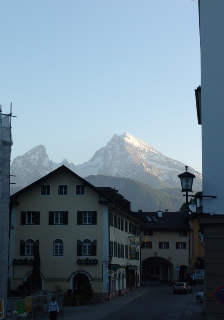
On Memorial Day Weekend, in order to avoid the 90°F+ heat (and no AC) in Mannheim and the rest of Central Europe, a friend of mine from Church and I escaped to the relative cool of the Alps, specifically Berchtesgaden. The reason for this otherwise obscure destination has its roots in the 1930 and Adolph Hitler. Upon the rise to power of the Nazi Party, the Party Elites siezed property on the Obersalzburg Plateau (overlooking Berchtesgaden), and took up residence. For his Birthday, Hitler was given the Kehlsteinhaus, high above the Obersalzburg (Americans know this as the Eagle's Nest). One of the most beautiful and scenic roads in the world led from Hitler's private residence on the plateau up to the Kehsteinhaus entrance. I will go into more about that later. In addition to the private residences of various Party Elites, a Party Guesthouse the Platterhof (Orignially opened in 1877 as the Pension Moritz).

In 1937, the Platterhof was remodeled into a sizeable hotel for Nazi Party Dignitaries. When the war ended in 1945, it stood significantly damaged from bombing raids and the occupation by US Forces. In 1952, when virtually all the rest of the Nazi buildings were razed, the Platterhof was renovated and became the Armed Forces Recreation Center (AFRC) Hotel General Walker - An alpine resort for American Servicemembers and their families.
 1955
1955
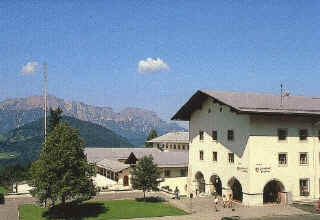 1981
1981
It was in this use that I came to know the General Walker. Every spring from 1984-1988, my family and I would spend a week attending the Episcopal Church Family Conference there. It was, in essence, my Vacation Home. I remember touring the Bunker System, seeing the ruins of Hitler's House, going into the Salt Mines, and all around revelling in the nearby Alpine meadows. In 1995, the General Walker was closed, and the property returned to the German Government. They chose to tear it down rather than let it become a monument to the Nazi Party. Today, the parking lot for the Kehstein Haus shuttle and the Nazi Party Documentation Center (documenting the horrors of the Nazi atrocities) take the place of the hotel. Only a set of stairs, an arcade (this has a double meaning for me), and the former "Skyline Room" restaurant of the hotel remain.

It is worth noting that many of the outdoor scenes in "The Sound of Music" were filmed around Berchtesgaden, and the mountains in the background are these very same mountains. Every time I see the movie, I think of my time here.
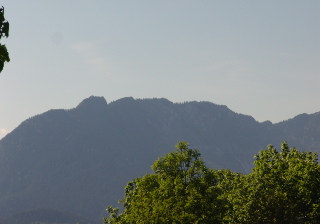
We stayed at a rather inexpensive gasthaus in the nearby village of Oberau, halfway down from the Obersalzberg Plateau, and a litteral stones-throw from the Austrian border.
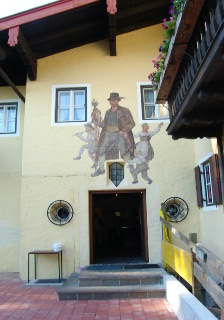
The rooms were very traditional, with communal bathroom and seperate shower rooms down the hall.

Sharing a parking lot with the Gasthaus was a rather unique church, with the entrance and bell tower on the side, rather than on the end.
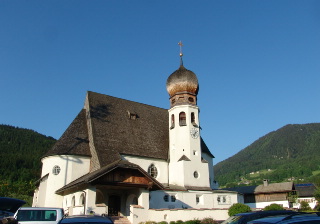
After settling into our rooms, we drove back into Berchtesgaden to tour the town. Despite it being tourist season, it was very quiet in town. Also, despite having been to town so many times years ago, I realized I was not really all that familiar with Berchtesgaden itself. It is a very picturesque and comfortable town.

We returned to our hotel for a traditional Bavarian dinner, and enjoyed the sunset over the mountains.
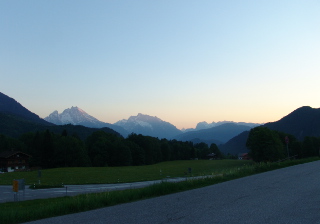
The next morning was brilliantly clear, and we set out early to see all that we could.
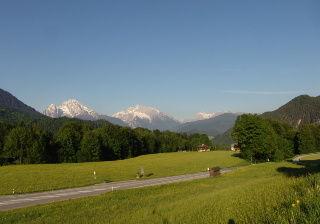
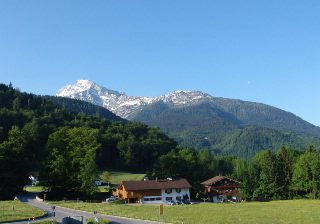
We started with the Kehlsteinhaus shuttle. From the depot on the Obersalzberg Plateu, we rode a bus up the steep narrow road that climbs the sometimes nearly sheer cliff face of the mountain, with breathtaking views out of the surrounding countryside.


At the top of the road, a tunnel is carved 100m into the mountain, where a golden elevator completes the final 100m of ascent to the Kehlsteinhaus.
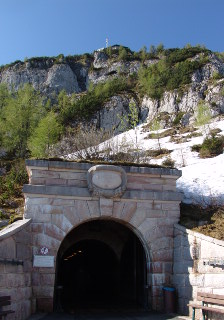
The view from the top is absolutely breathtaking.
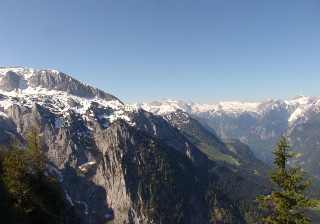
We hiked up the path from the Eagle's Nest to a nearby summit (not the overall mountain summit however) where I took this classic photo of the Kehlsteinhaus.
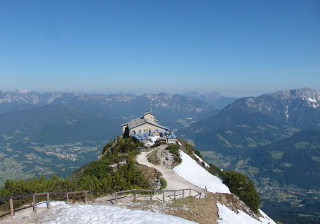
Also up there is a wooden cross, placed in 2003 to replace the original one erected in 1951. I rather suspect the original was the victim of Lightning or similar during the winter of 2002-2003. This is one of my all time favorite of my pictures.

We continued our hike further up to the summit - an outcrop of rock that has quite obviously been well climbed over the past 60 years.

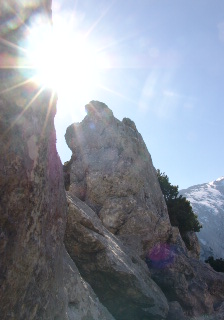
Before heading back down to the Kehlsteinhaus, I got a picture of myself taken at the foot of the cross - it turns out just after I lost my good sunglasses (I didn't realize it until we got a good ways down).
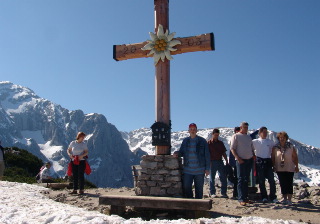
The Kehlsteinhaus was built as a birthday gift for Adolph Hitler. He seldom used it before the war, and after the invasion of Poland he was too occupied to return to it. his relative disinterest in it is part of why it was not razed with most of the remainder of the Nazi buildings after the war. Today it is a restaraunt with one of the best views in the world (and prices to match).
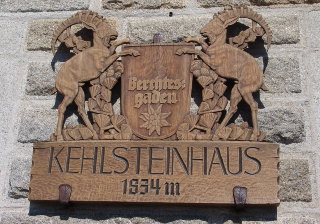
All too soon, our reserved return time came upon us, and we were headded back down the mountain.
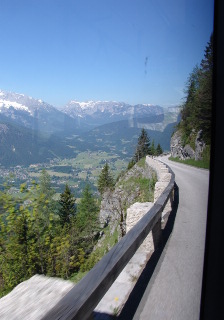
Our next stop (after eating a late breakfast on the former terrace of the General Walker) was the Salzbergwerk salt mine. No flash photography was permitted, so I could only get viable pictures of the only well illuminated location so far underground - a large saltwater lake that was made to pull the salt out of the rock.

We took a mid-day detour up to the scenic chapel of Maria Gern, a few miles north of Berchtesgaden.
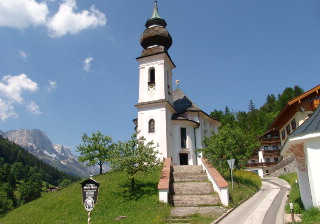
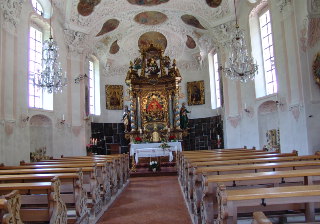
As we returned to the valley, we could see the clouds beginning to build over the mountains.
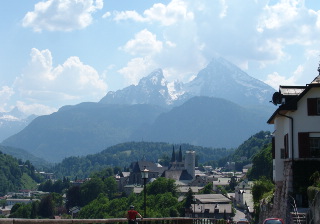
Our next destination was the Königsee, a long narrow lake that fills a valley alongside the Watzmann peaks. Tour-boats depart from Schönau am Königsee and provide the only way to access the chapel of St. Bartholomä and points south.

St. Bartholomä is situated on the west bank of the lake, about 2/3 of the way south. This chapel is very much the symbol of Königsee, with several scenic houses and buildings around it.
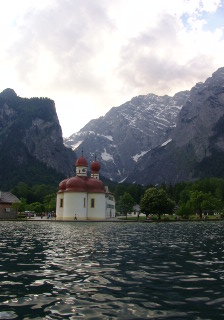
Numerous hiking and clibming trails wind their way up the side of teh Watzmann from this Alpine Meadow alongside the chapel.
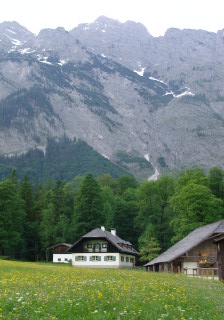
At the southern end of the lake is the "village" of Salet, really not much more than a lose collection of about 3 houses, it is the stepping off point for more trails.

A 15-20 minute hike from the dock lies the scenic Obersee, almost more of an offshoot of the Königsee, this lake almost begs for travelers to explore the extreme tip of this German Salient into Austria. We did not have time to do more than take a few pictures before hiking back to catch the last boat of the day.
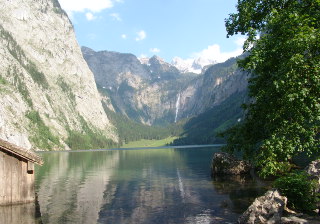
We returned to Schönau, and had dinner by the lakeshore before returning to our gasthaus for dessert and the sunset.
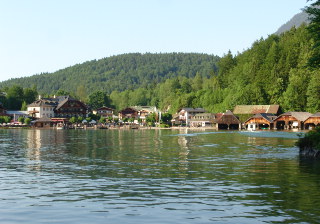
The next morning was Sunday, and Sunday in Bavaria is always special. Bavarians in this area dress in their Sunday Best, which is the traditional Bäyrische attire.
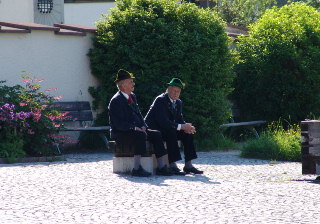
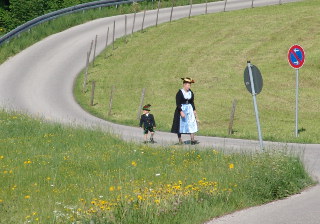


Alas, it could not last forever, so after breakfast we began our return trip, but made sure to take the detour through Austria just to say we did.
Someday, I'll have to return, and make sure to hit Salzburg as well.
Vintage Pictures courtesy of http://www.thirdreichruins.com 


 1955
1955 1981
1981
































